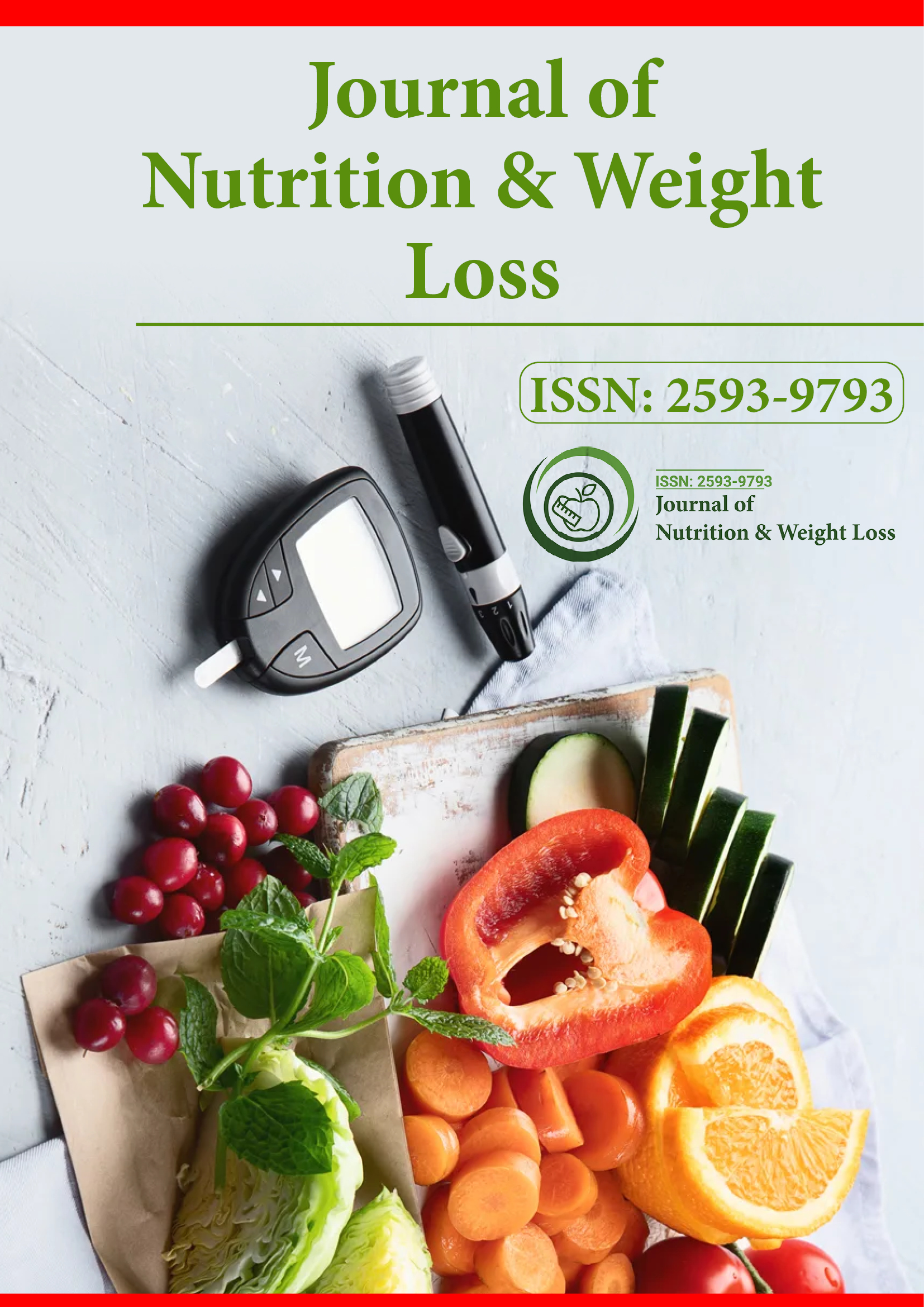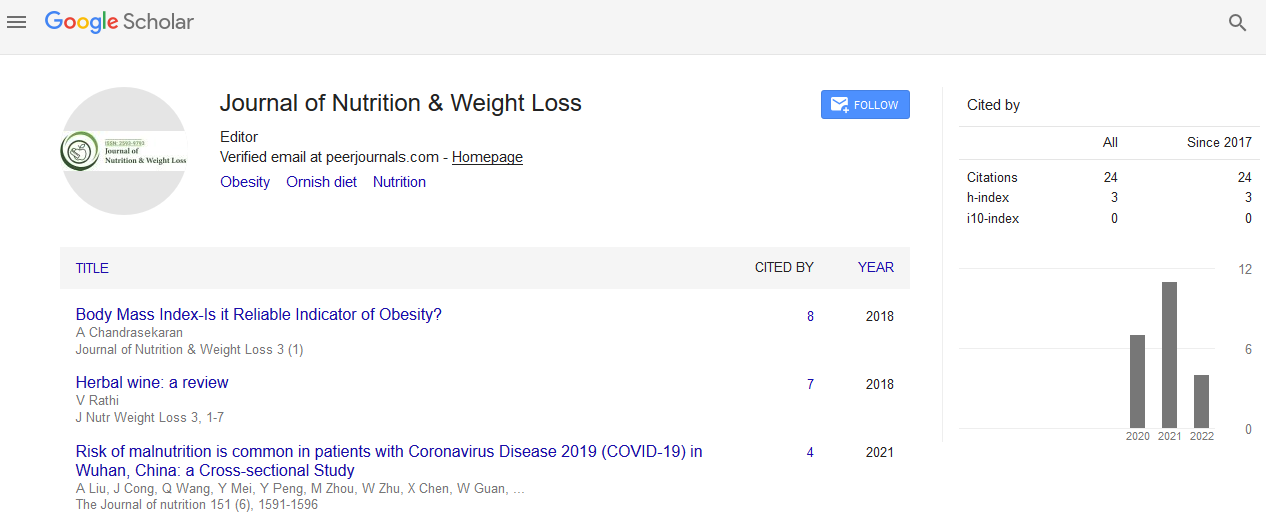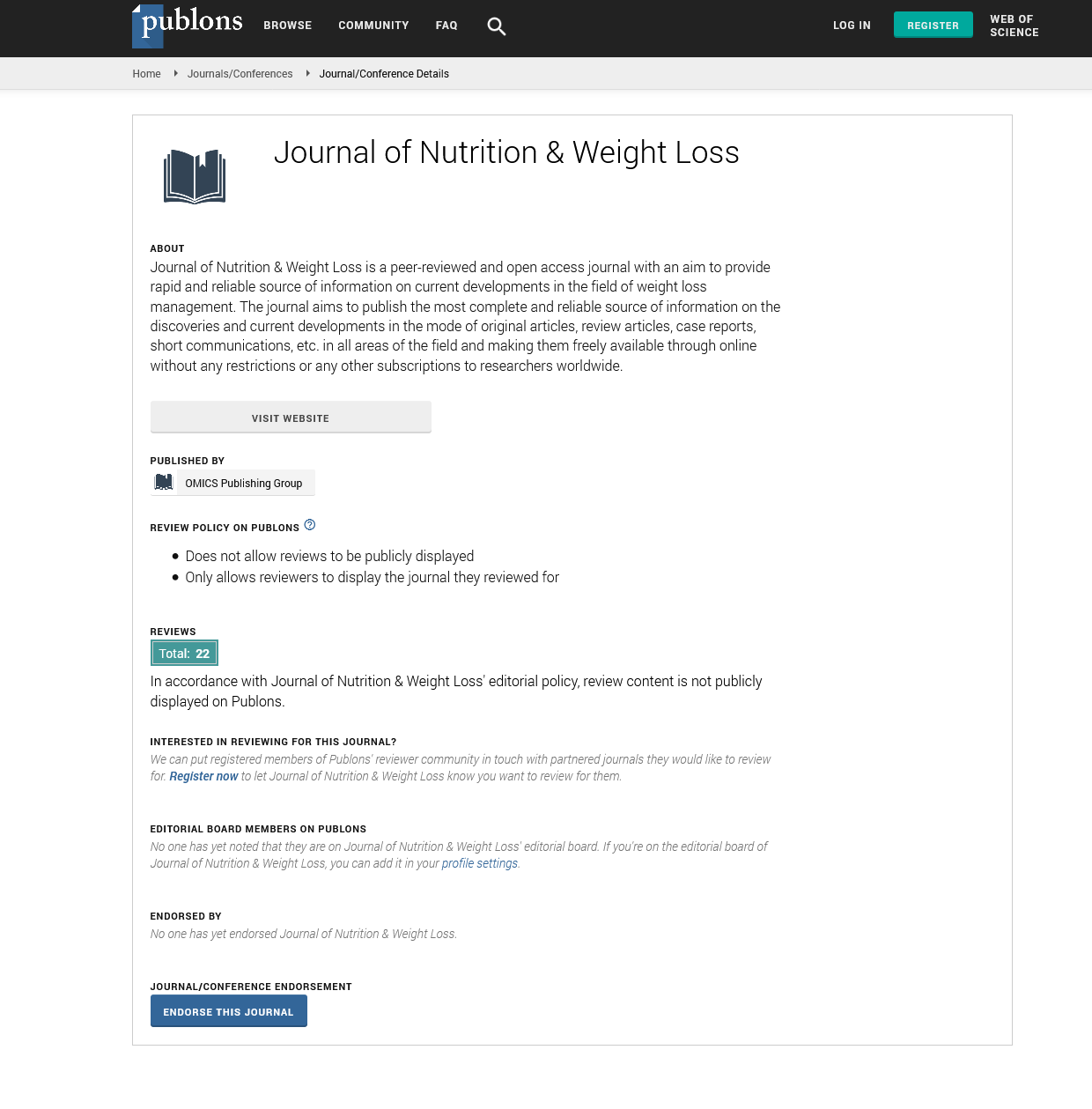Indexed In
- RefSeek
- Hamdard University
- EBSCO A-Z
- Publons
- Euro Pub
- Google Scholar
Useful Links
Share This Page
Journal Flyer

Open Access Journals
- Agri and Aquaculture
- Biochemistry
- Bioinformatics & Systems Biology
- Business & Management
- Chemistry
- Clinical Sciences
- Engineering
- Food & Nutrition
- General Science
- Genetics & Molecular Biology
- Immunology & Microbiology
- Medical Sciences
- Neuroscience & Psychology
- Nursing & Health Care
- Pharmaceutical Sciences
Commentary - (2021) Volume 0, Issue 0
Role of Diet and Nutrition in Leprosy
Sonika Sharma*Received: 09-Nov-2021 Published: 30-Nov-2021, DOI: 10.35248/2593-9793.21.s4.144
Commentary
Leprosy, once conside red as helpless man's illness might cause extreme neurological complexities and actual handicaps. Grouping of Leprosy relies on the cell intervened and humoral safe reactions of the host, from tuberculoid to lepromatous stage. Momentum treatment to forestall the illness isn't without a doubt, exceptionally extended yet in addition comprises of costly various anti-infection agents in mix. Treatment and the term rely upon the bacillary burdens, from a half year in paucibacillary to a year in multibacillary infection. In spite of the fact that according to WHO suggestions, these anti-microbials are unreservedly accessible yet unattainable to patients of numerous provincial spaces of the world. In this survey, we have zeroed in on the healthful perspective during the multi-drug treatment of Leprosy alongside the job of sustenance, especially hunger, on defenselessness of Mycobacterium leprae and improvement of clinical manifestations. We further talked about the eating routine arrangement for the patients and what diet plans can mean for the insusceptible reactions during the infection.
Leprosy is a persistent crippling bacterial sickness brought about by intracellular sluggish developing gram positive corrosive quick bacillus Mycobacterium leprae (M. leprae), or seldom with M. lepromatosis, recognized by scientist. The most established proof for infection traces all the way back to 600 BC in India, while genomic studies from skeletal remaining parts recommend that lepromatous sickness was available in India around 2000 B.C. Further, the presence of disease during the post metropolitan period of the Indus progress recommends that M. leprae developed in Africa and moved to India before the Late Holocene, during the third thousand years B.C. The brooding time of M. leprae shifts from 3-5 years and is spread through air beads of the nasal and oral release from non-treated multibacillary disease patients or potentially by means of advanced impregnation of skin. Curiously more than almost 100% of the populace has sufficient normal invulnerability against disease and 85% of the clinical cases are non-irresistible. Also, an irresistible individual can become non irresistible inside seven days of the main portion of treatment.
Infection chiefly influences the skin and fringe nerves, alongside the mucosa of the upper respiratory lot and the eyes, prompting the moderate and extremely durable nerve harm to deformations to loss of motion. In v iew of bacillary burden disease is named paucibacillary and multibacillary structures. PB Leprosy is a gentle structure with 2-5 pale or ruddy skin sores, though MB comprises of in excess of five skin injuries, knobs, plaques, thickened dermis or skin invasion. All things considered, disease was excluded by society for its serious nature. Because of the shortfall of any cell or creature model, understanding with regards to the science of Leprosy bacillus generally stays obscure. Albeit M. leprae fill in mice footpads yet neglected to cause nerve harm; while it causes nerve harm in armadillos, a seldom utilized creature in research. The situation has changed with the presentation of dapsone during the 1940s and consequently the multi-drug treatment by the WHO utilizing a blend of dapsone, rifampin and clofazimine or clarithromycin. The MDT treatment for PB and MB shifts from 6 and a year separately, without backslides or repeats or the advancement of opposition, with a plan to decrease the grade two actual inabilities. Ongoing investigations by WHO assessed that the worldwide weight of disease was drastically diminished from 5.2 million.
Being a helpless man's infection, sickness stays a general medical issue in immature countries. The connection between the danger variables and improvement of sickness is as yet muddled on the grounds that it is hard to explore the causal connections of disease and the beginning of manifestations because of the long brooding time frame (3-5 years) of M. leprae. Besides, in view of the Ridley-Jopling order there are five clinical structures: tuberculoid, lepromatous, fringe tuberculoid, mid-fringe, and lepromatous fringe. The particular danger factors for reaching Leprosy, besides in endemic regions, incorporate record patient, age of the contact, actual distance to the patient and destitution. In spite of the fact that its relationship with weakness and clinical advancement is hazy numerous helpless nations have low predominance rates; while monetarily creating Brazil had one of the greatest new case identification rates. Case-control studies on financial elements from Brazil and Bangladesh uncovered that food deficiency whenever of life was related with sickness. It was clear that when rice costs are high and pay is low the family compelled to lessen the quantity of dinners daily, or the admission of food sources. Lacking food consumption prompts diminished admission of carbs, proteins, fats, nutrients, and minerals; and the healthful inadequacy impedes the invulnerable framework against diseases. Albeit the danger of subclinical contamination isn't constantly identified with food deficiency yet it helps in advancing the disease to the clinical infection.
Leprosy shows an assortment of clinical highlights with complex show and multifactorial danger, subsequently its administration is an enormous test. Most of people is neither contaminated nor creates sickness following normal openness because of their regular resistance. Indeed, even individuals with idle M. leprae disease might foster just a solitary self-mending injury, yet untreated or doesn't recuperate it might advance into the PB or MB. Ongoing investigations showed that NOD2-interceded flagging, nutrient D-subordinate antimicrobial pathways, interferons, T-administrative Th-17/IL-17A/IL-17F cytokines, CD163 and galectin-3 play part in disease control. Notwithstanding, the intracellular bacterium M. leprae could stay away from resistant reconnaissance, notwithstanding the inborn safe reaction by the skin epithelium and keratinocytes during bacterial passage into the skin and fringe nerves, while keratinocyte gets an invulnerable reaction by mannose-restricting receptors,TLRs, cytokines, chemokines and antimicrobial peptides. Besides, human keratinocytes have the phagocytic capacity with the outflow of antimicrobial elements CD80, CD209, cathelicidin, TNF-α and IL-1β; and M. leprae actuate cytokines and chemokines in keratinocytes to kill the bacterium with the assistance of LCs, DCs, T-cells, and neutrophils. So the most ideal method for forestalling the spread of infection is early finding and treatment. Prompt and yearly assessments are essential for no less than five years after last contact with an irresistible patient with satisfactory nutritious eating regimens to the person in question, relatives, and close contacts to improve/reinforce invulnerability.
Leprosy can fill in as a ghostly model of natural and versatile resistant reaction so far insurance and pathogenesis are concerned yet are moderately understudied comparable to its effect on wholesome variables. Infection is known to be affected by hereditary and natural variables and the patient's decreased cancer prevention agent status. The significance of sustenance, especially the equilibrium between protein and micronutrients should be examined, as the sickness consumes a large chunk of the day to create, and in this manner the wholesome equilibrium might diminish the danger of procuring the infection. Besides, a decrease in cancer prevention agent and supplement levels prompts expanded oxidative pressure, alongside skin and neurological problems during M. leprae disease. Hence, further examinations on the job of supplements, especially immuno-modulatory supplements should be re-explored to clarify pathogenic instruments.
On the whole, this survey featured the current status of sickness and its invulnerable system with the job of food and nourishment in its administration. The stockpile of nutritious food to all individuals from an infection patient family is the main element alongside related boundaries including BMI, per capita food consumption, food stockpiling, and so forth Neediness alone prompts low utilization of protein food varieties, organic products, and vegetables prompting wholesome insufficiency, and delayed healthful inadequacies lead to a disabled invulnerable reaction, prompting clinical sickness. Hence, future examination ought to be coordinated on the relationship of sickness and sustenance, and the job of the immunoregulatory pathway for infection the board.
Citation: Sonika S (2021) Role of Diet and Nutrition in Leprosy. J Nutr Weight Loss. 6:144.
Copyright: © 2021 Sonika S, This is an open-access article distributed under the terms of the Creative Commons Attribution License, which permits unrestricted use, distribution, and reproduction in any medium, provided the original author and source are credited


